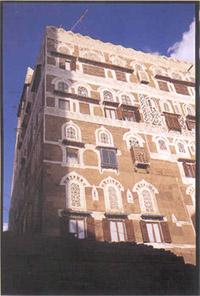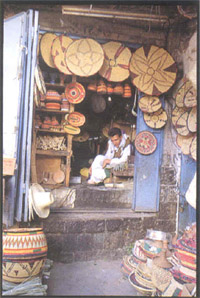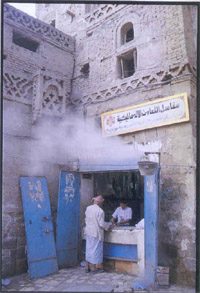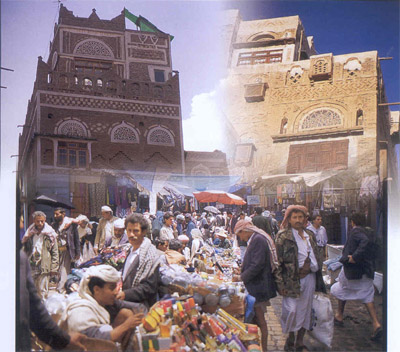 |
One
of the first things you notice when you
step from the plane at Sana'a airport is
the fact that climbing steps is more
difficult here than in Dubai. Sana'a lies
at an altitude of some 2000 meters and it
takes a few days before a person used to
sea-level air is adapted to such a high
altitude. The next thing you notice, when
your transport takes you into town, is the
unusual architecture of both old and new
buildings.
The high tower-houses of Yemen are famous
around the world. Long before high-rises
and skyscrapers were built in the Western
world, the ancient builders in this corner
of Arabia were able to erect multi-storeyed
buildings from mud-bricks. The outside
decoration are beautiful: elaborate white
plaster "lacework" around the
windows and in several horizontal bands
adorn each fašade. Many of the windows
are half-moon shaped and made of a mosaic
of coloured glass. Inside, these windows
throw wonderful patterns on the simple
floors and walls of the rooms. Narrow
winding staircases with unequal steps lead
from floor to floor until they reach the
flat roof from where you can have great
views across the city or the countryside.
 One of the best places in Sana'a to see
this architecture, besides much more, is
the central suq,
the Bab-al-Yemen. It is by far the most
authentic and interesting suq
that I have seen anywhere in Arabia. You
enter it via a large gate in the wall that
once surrounded the ancient city. This
brings you onto a large square that holds
a milling crowd of sellers and buyers.
Small stalls line the paths but most of
the goods sold here are the cheap plastic
wares from the Far East as well as some
local produce. The actual market lies
beyond, in the maze of narrow alleys that
radiate from this central square. The
square is lined with perfect examples of
the famous architecture, rising up high
into the blue sky. Somewhere along the
alleys is a small museum that you can
enter to have a look at the small rooms
and winding staircases, well worth the
effort.
One of the best places in Sana'a to see
this architecture, besides much more, is
the central suq,
the Bab-al-Yemen. It is by far the most
authentic and interesting suq
that I have seen anywhere in Arabia. You
enter it via a large gate in the wall that
once surrounded the ancient city. This
brings you onto a large square that holds
a milling crowd of sellers and buyers.
Small stalls line the paths but most of
the goods sold here are the cheap plastic
wares from the Far East as well as some
local produce. The actual market lies
beyond, in the maze of narrow alleys that
radiate from this central square. The
square is lined with perfect examples of
the famous architecture, rising up high
into the blue sky. Somewhere along the
alleys is a small museum that you can
enter to have a look at the small rooms
and winding staircases, well worth the
effort.
 Immediately when you enter the streets of
the suq,
you smell the wonderful smells of Arabia:
freshly roasted coffee, cardamom, fresh
mint, dozens of other spices, sweet halawa
and honey. Salesmen sit in the middle
of their wares, shouting as you pass. Dark
basements give a fleeting glimpse of
coffee houses, where the shisha
(waterpipe) is a permanent fixture. In one
such a dark basement you can see a
blind-folded camel turning the grindstone.
This is where sesame oil is extracted from
the tiny seeds. From time to time the
camel is led out onto the street and tied
to the support of a balcony, where it
calmly chews its cud, observing the
crowds.
Immediately when you enter the streets of
the suq,
you smell the wonderful smells of Arabia:
freshly roasted coffee, cardamom, fresh
mint, dozens of other spices, sweet halawa
and honey. Salesmen sit in the middle
of their wares, shouting as you pass. Dark
basements give a fleeting glimpse of
coffee houses, where the shisha
(waterpipe) is a permanent fixture. In one
such a dark basement you can see a
blind-folded camel turning the grindstone.
This is where sesame oil is extracted from
the tiny seeds. From time to time the
camel is led out onto the street and tied
to the support of a balcony, where it
calmly chews its cud, observing the
crowds.
Another shop spews thick clouds of steam -
the local laundry is doing brisk business.
Beautifully handcrafted baskets, mats and
fans are sold in the next stall. The
relaxed salesman is also chewing a cud -
of qat.
This is a local custom that you can see
everywhere from the late morning till the
evening. Qat
is a plant that gives the same pleasure as
tobacco. It is cultured on practically all
arable land in Yemen, and everybody seems
to be using it. Thick wads of leaves are
stuffed into the cheek, causing everyone
to sit and walk around with one half of
their faces swollen to balloon size.
 Many of the shops sell bedu
jewellery and antiques. Much of it is
authentic as yet, though that may change
soon if tourism takes off here. You can
spend a fortune here
- on the Yemeni daggers (but only
if the grip is made of cowbone, not of
rhino horn!), on necklaces of silver and
turquoise or malachite beads, on old
artifacts, and newly made soapstone
containers. These latter are copies of
ancient items found in archaeological
digs, with beautiful simple designs and
decorations.
Many of the shops sell bedu
jewellery and antiques. Much of it is
authentic as yet, though that may change
soon if tourism takes off here. You can
spend a fortune here
- on the Yemeni daggers (but only
if the grip is made of cowbone, not of
rhino horn!), on necklaces of silver and
turquoise or malachite beads, on old
artifacts, and newly made soapstone
containers. These latter are copies of
ancient items found in archaeological
digs, with beautiful simple designs and
decorations.
Wildlife also appears in the suq
from time to time. The founder male of the
breeding program for Arabian leopards here
in the UAE came from a suq
like this. He was caught as a youngster
together with his mother, who was shot
trying to defend him. After two years in
miserable conditions, being shown from
village to village in a tiny cage, he was
acquired by a Sharjah-based conservation
organisation and paired with a
captive-bred female. He was named Nimrod
Felix. The first name is a pun on the
local word for leopard (nimr)
- Nimrod was a hunter in Greek mythology.
Felix (= happy, prosperous), indicates
that he was lucky to be rescued, but also
that he came from "Arabia felix",
which is the old name for Yemen. Arabia
felix is a wonderful place that is a
tourist paradise. In spite of reports of
tourists or foreign residents being
kidnapped, it is not an unsafe place to
travel, as long as you stick to the main
cities and roads. With its riches in both
historical and natural heritage, tourism
could be developed here to bring in
much-needed currency, in order to develop
some infra-structure and give jobs to
people who now cannot find employment.

|
